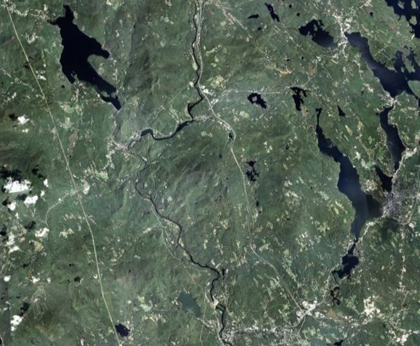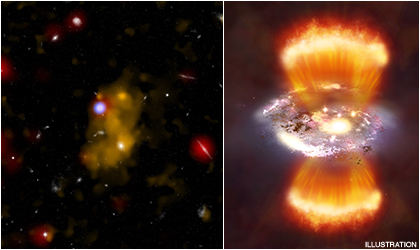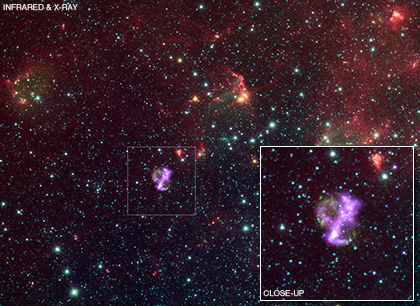A Galaxy Collision in Action
This beautiful image gives a new look at Stephan's Quintet, a compact group of galaxies discovered about 130 years ago and located about 280 million light years from Earth. The curved, light blue ridge running down the center of the image shows X-ray data from the Chandra X-ray Observatory. Four of the galaxies in the group are visible in the optical image (yellow, red, white and blue) from the Canada-France-Hawaii Telescope.
A Super-Efficient Particle Accelerator
This image of data from NASA's Chandra X-ray Observatory and the European Southern Observatory's Very Large Telescope shows a part of the roughly circular supernova remnant known as RCW 86. This remnant is the remains of an exploded star, which may have been observed on Earth in 185 AD by Chinese astronomers. By studying this remnant, a team of astronomers was able to understand new details about the role of supernova remnants as the Milky Way's super-efficient particle accelerators.
Seamless Astronomy and Remote Collaborations
Pepi Fabbiano is a senior astrophysicist at the Smtihsonian Astrophysical Observatory. In addition to her duties with Chandra and her research into galaxies, black holes, and other aspects of the high-energy Universe, she also actively involved in helping bringing astronomy and its tools into the 21st century.
I am just back from the spring meeting of the International Virtual Observatory Alliance (IVOA). The IVOA is an international collaboration of astronomers and computer scientists aimed at connecting via the internet archives of astronomical data world-wide. These are observations of the sky both from the ground and space and include X-ray data Chandra together with radio, optical, infrared and ultraviolet observations. The purpose of the IVOA is to develop standards so that anyone can retrieve data from the participant archives, publish their own observations to the world, and make the data "play together" to discover new aspects of the universe.
Galaxies Coming of Age in Cosmic Blobs
A deep study of 29 gigantic blobs of hydrogen gas has been carried out with NASA's Chandra X-ray Observatory to identify the source of immense energy required to illuminate these structures. These mysterious blobs - called "Lyman-alpha blobs" by astronomers because of the light they emit - are several hundred thousand light years across and are seen when the Universe is only about two billion years old, or about 15% of its current age.
From Earth to the Universe & the World Science Festival
Washington Square Park of New York City was transformed into a "science wonderland" on Sunday, June 14, 2009 when the World Science Festival Youth and Family Street Fair returned for its second year.
Supernova Remnant is an Unusual Suspect
A new image from NASA's Chandra X-ray Observatory shows a supernova remnant with a different look. This object, known as SNR 0104-72.3 (SNR 0104 for short), is in the Small Magellanic Cloud, a small neighboring galaxy to the Milky Way. Astronomers think that SNR 0104 is the remains of a so-called Type Ia supernova caused by the thermonuclear explosion of a white dwarf.
The Numbers are Just a Tool
Martin Elvis is a senior astrophysicist at the Smithsonian Astrophysical Observatory. When not getting bumped up to business class, he studies quasars and other fascinating phenomena in the Universe with Chandra and other telescopes.

Copyright: Smithsonian Institution, from SI Research Reports
Taking Our Galactic Self-portrait
One of Chandra's most iconic images is that of the center of our Galaxy. We should say, more accurately, that this image is just a small piece of Milky Way's center. This image - which stretches some 900 light years in one direction and 400 light years in the other - is actually a montage of 30 separate Chandra images that have been stitched together to create this stunning X-ray tableau. Even with all of that data, this image still only represents a small fraction of the plane of the Milky Way, which stretches some 100,000 light years across (again, compared to just 900 light years in our image.) But even in that relatively small space, we see how amazing our Galaxy is. There's a supermassive black hole and hundreds of other objects, including neutron stars, smaller black holes, stars and more.
But when do we get a full picture of the Milky Way? The answer is we don't. Since our Solar System is embedded within our Galaxy, we never get a real astronomical image of what it looks from the outside as produced by a telescope. (What we see when we are "looking" at a complete picture of the Milky Way is an artist's representation - or another spiral galaxy that is standing in as its stunt double.)
Ghost Remains After Black Hole Eruption
This is a composite image showing a small region of the Chandra Deep Field North. Shown in blue is a deep image from the Chandra X-ray Observatory and in red is an image from the Multi-Element Radio Linked Interferometer Network (MERLIN) an array of radio telescopes based in Great Britain. An optical image from the Sloan Digital Sky Survey (SDSS) is shown in white, yellow and orange.
A GPS System for Cosmic Images
Imagine getting a picture of some random patch of the Earth. This picture has some features on it - maybe a mountain or a river or even a city - but from the altitude it was taken, you can't be exactly sure what's what. And then imagine if someone asked you to place it exactly where it should lie on the Earth. Really hard, right?

It's New Hampshire - USA
Well, of course, it gets a lot easier if someone were to give you the exact longitude and latitude. While this seems like an obvious thing to do, it's not so simple for astronomical images. When astronomers create their images for scientific purposes, these images retain certain coordinate information - like longitude and latitude - but for space. Unfortunately, when these images get processed further to make them attractive for the public, this information gets stripped out. In other words, we're back to having no clue where this image matches up with anything else.




